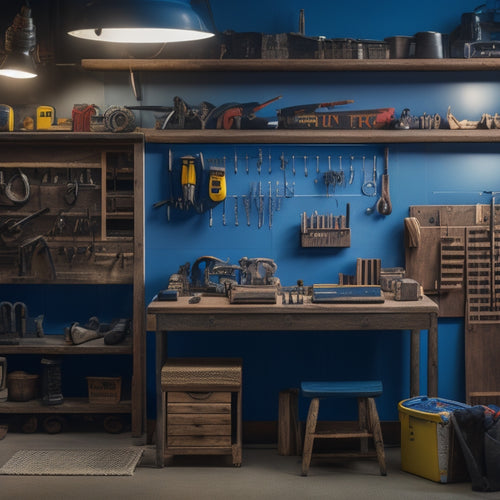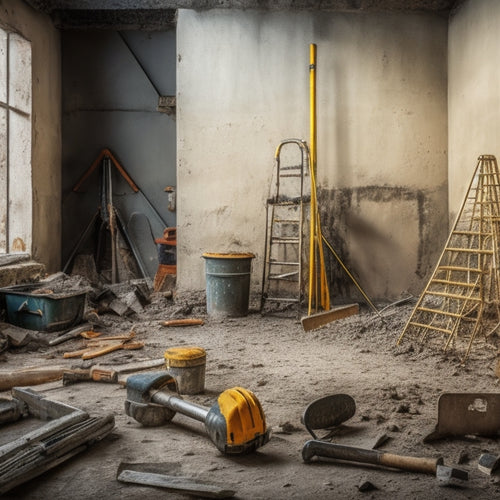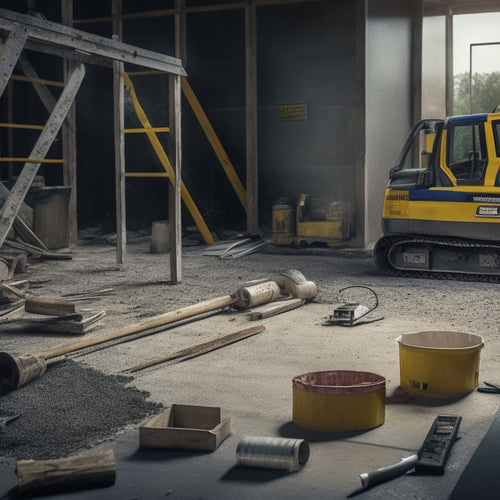
Budget Bricklaying Kit for Home Renovators
Share
As a home renovator on a budget, you'll need a solid bricklaying kit to achieve professional results. Key tools include a trowel, jointer, spirit level, hammer, and string line. Opt for affordable trowel materials like carbon steel or fiberglass, and consider budget-friendly leveling tools like laser levels or leveling rods. Instead of a spirit level, try a water level trick or smartphone app. Select a reliable hammer with a flat rectangular head and straight claw, and don't forget essential safety gear like hard hats, safety glasses, and work gloves. With these tools and some creativity, you'll be well on your way to mastering bricklaying techniques - and there's more to explore as you progress.
Key Takeaways
• Invest in essential tools like levels, trowels, jointers, hammers, and string lines to ensure quality bricklaying results.
• Choose budget-friendly options for leveling tools, spirit levels, and joint rakers without compromising on accuracy and durability.
• Select the right trowel material, size, and notch type for the project, considering factors like durability, weight, and ergonomic handles.
• Prioritize safety gear essentials like hard hats, safety glasses, and breathable work gloves to protect against construction site hazards.
• Opt for discounted mixing bucket solutions and explore inexpensive brick cutting techniques to stay within budget without sacrificing quality.
Essential Bricklaying Tools List
You'll need the following essential tools to get started with bricklaying: a level, a trowel, a jointer, a spirit level, a hammer, and a string line.
Don't even think about attempting those intricate bricklaying techniques without them! With these tools, you'll be well on your way to mastering the art of laying bricks like a pro.
When sourcing materials, make sure you've got the right type of bricks, sand, and cement for your specific project.
Don't skimp on quality – it'll cost you in the long run. Measure twice, order once, and always keep a few extras on hand, just in case.
Affordable Trowel Options Available
Selecting the right trowel for your bricklaying project is critical, and fortunately, there are several affordable options available that won't break the bank.
When it comes to trowel material comparison, you'll find that stainless steel, carbon steel, and fiberglass are popular choices. Stainless steel trowels are durable and resistant to corrosion, while carbon steel trowels are more budget-friendly but may require more maintenance. Fiberglass trowels are lightweight and easy to handle, making them perfect for beginners.
When choosing a trowel, consider the size of your project and the type of bricks you're working with. A trowel size guide can come in handy here. A smaller trowel (around 4-6 inches) is ideal for small projects or intricate work, while a larger trowel (around 10-12 inches) is better suited for larger projects or commercial applications.
Don't forget to check the handle material and grip comfort, as these factors can affect your overall experience. With a little research and patience, you can find an affordable trowel that meets your needs and helps you achieve professional-looking results.
Happy bricklaying!
Budget-Friendly Leveling Tools
When it comes to guaranteeing your bricklaying project is level and plumb, investing in the right leveling tools is vital. Fortunately, there are budget-friendly options available that can help you achieve accurate results without breaking the bank. You don't need to splurge on high-end tools to get the job done.
For instance, a budget-friendly laser level can help you achieve precise leveling techniques, confirming your walls are straight and your floors are even. These tools project a level line or dot onto your surface, making it easy to check your work as you go.
Another important tool for budget grading is a leveling rod. This simple, yet effective tool allows you to measure and mark precise levels on your surface. You can use it in conjunction with your laser level to double-check your work and verify accuracy.
With these budget-friendly leveling tools, you'll be able to achieve professional-looking results without draining your wallet. So, don't let budget constraints hold you back from achieving a level and plumb bricklaying project – invest in these affordable tools and get the job done right!
Cheap Spirit Level Alternatives
Your bricklaying project's accuracy relies on precise leveling, and a spirit level is typically the go-to tool for this task. However, if budget constraints are an issue, there are cheap alternatives that can deliver comparable results. Don't sacrifice accuracy for affordability; instead, get creative with these DIY spirit level alternatives.
Here are some budget-friendly options:
-
The Water Level Trick: Fill a long, clear tube with water and mark the level on each end. This makeshift level is surprisingly effective for smaller projects. Just be sure to account for any air bubbles!
-
The Smartphone App: Download a leveling app, such as Clinometer or Level Master, which uses your phone's accelerometer to detect even the slightest tilts. This option is perfect for quick checks and is often more accurate than you'd expect.
-
The DIY Bubble Level: Create your own bubble level using a wooden or plastic ruler, a small glass vial, and some water. This low-tech solution may not be as fancy as a store-bought level, but it gets the job done.
These spirit level alternatives mightn't be as flashy as the real deal, but they'll help you achieve professional-looking results without breaking the bank.
DIY Bricklaying Hammer Choices
With leveling out of the way, you're ready to tackle the physical aspect of bricklaying, and that starts with a reliable hammer.
Don't even think about reaching for that rusty old thing in the back of your toolbox – you need a hammer specifically designed for bricklaying. Look for a hammer with a flat, rectangular head and a straight claw. This will give you the precision and control you need to tap those bricks into place.
When choosing a hammer, consider the weight and balance – you want something that feels comfortable in your hand, but still packs a punch.
And don't forget about tool maintenance! Regularly clean and oil your hammer to keep it in top condition. A well-maintained hammer will help you master those bricklaying techniques and get the job done efficiently. Trust us, your back (and your bricks) will thank you.
With the right hammer, you'll be laying bricks like a pro in no time!
Low-Cost Joint Raker Options
After selecting the ideal hammer, you'll need a joint raker that can efficiently remove excess mortar from between the bricks. Fortunately, you don't have to break the bank to get a reliable one.
When it comes to joint raker materials, you've got options. You can opt for a budget-friendly steel joint raker, which is durable and gets the job done. Alternatively, you could splurge (just a little) on a high-carbon steel joint raker, which offers superior strength and corrosion resistance.
Here are some joint raker techniques to keep in mind:
-
Use a gentle, sweeping motion to remove excess mortar, taking care not to scratch the surrounding bricks.
-
Experiment with different joint raker angles to find the one that works best for your specific project.
-
Don't be afraid to get creative with your joint raker – it can also be used to scrape out old mortar before repointing.
Economical Safety Gear Essentials
When you're working on a budget bricklaying project, you can't afford to compromise on safety.
You'll need to prioritize essential head protection, ensuring your hard hat meets industry standards for impact resistance and comfort.
Next, you'll want to focus on safety glasses that meet ANSI Z87.1 requirements and breathable work gloves that provide grip and protection without compromising dexterity.
Essential Head Protection
You'll need a reliable hard hat that meets industry standards to safeguard your head from falling debris, sharp objects, and other hazards on the construction site.
Don't think you can get away with a flimsy helmet, because a good hard hat is essential to your survival (and your hairdo). You want a helmet that's sturdy, comfortable, and adjustable - after all, you'll be wearing it for hours on end.
Here are some key features to look for in a hard hat:
-
Impact resistance: Your hard hat should be able to withstand a blow from a falling object without compromising its structural integrity.
-
Ventilation: A breathable helmet will keep you cool and focused, even on the hottest construction days.
-
Adjustability: A one-size-fits-all approach won't cut it here; look for a hard hat that can be adjusted to fit your unique head shape.
Safety Glasses Requirements
Your eyes are equally vulnerable to hazards on the construction site, and that's why you need safety glasses that provide reliable protection without breaking the bank.
According to safety regulations, eye protection is a must-have on any construction site, and you shouldn't compromise on it. When choosing safety glasses, look for ones that meet the American National Standards Institute (ANSI) standards for impact resistance. You'll want glasses with polycarbonate lenses that can withstand flying debris and other hazards.
Opt for glasses with a wraparound design to guarantee maximum protection. You should also consider anti-fog coatings and scratch-resistant lenses to guarantee clear vision.
Don't forget about comfort – you'll be wearing these glasses for hours, so choose ones with soft, cushioned frames and adjustable temples. With safety glasses, you get what you pay for, but that doesn't mean you need to break the bank.
Look for affordable options that meet safety regulations, and you'll be able to focus on your bricklaying project without worrying about your eyes. Remember, eye protection is no joke – it's an essential part of your overall safety kit.
Breathable Work Gloves
With bricklaying tasks requiring a firm grip and dexterity, breathable work gloves become an essential component of your economical safety gear. They provide protection from abrasions and cuts while keeping your hands cool and dry.
You don't want to be stuck with sweaty, blistered hands mid-project, do you?
When shopping for breathable work gloves, look for:
-
Breathable materials: Opt for gloves made from lightweight, porous materials like mesh or synthetic fabrics that allow for airflow and moisture-wicking. This will keep your hands dry and comfortable throughout the project.
-
Glove durability: Assess the glove's construction and quality of materials. A durable glove will withstand the rigors of bricklaying, providing long-lasting protection and grip.
-
Fit and dexterity: Choose gloves that fit snugly, allowing for flexibility and precision. You want to be able to grasp and manipulate bricks with ease, not struggle with bulky, restrictive gloves.
Discounted Mixing Bucket Solutions
Mixing buckets, an essential component of any bricklaying kit, can be sourced at a fraction of the cost through discounted solutions that prioritize functionality over aesthetics.
You don't need a fancy-schmancy bucket to get the job done. What you do need is a reliable, sturdy container that can withstand the rigors of mixing mortar and concrete.
Look for buckets made from heavy-duty polypropylene or steel, which can handle the weight and abrasion of your mixing techniques. A discounted bucket solution mightn't come with all the bells and whistles, but it'll get the job done.
You can save even more by opting for a plain-Jane bucket without any fancy branding or logos. After all, it's what's inside the bucket that matters, not the bucket itself.
With a discounted mixing bucket, you can allocate more of your budget to the important stuff – like actually building that wall or patio you've been dreaming of.
Inexpensive Brick Cutting Methods
Cutting bricks accurately and efficiently is essential to achieving professional-looking results, and you can do so without breaking the bank by employing inexpensive brick cutting methods that rely on manual tools and techniques.
As a DIY enthusiast, you don't need to invest in expensive machinery to get the job done. With a little creativity and elbow grease, you can achieve precise cuts without breaking the bank.
Here are some DIY brick cutter techniques and alternative cutting tools to get you started:
-
Hammer and chisel: This old-school method is still effective for cutting bricks. Simply score the brick with a chisel and then break it along the line with a hammer.
-
Masonry saw: A masonry saw is a manual saw designed specifically for cutting through brick and concrete. It's a great alternative to power saws and can be purchased at a fraction of the cost.
-
Tile nippers: Believe it or not, tile nippers can be used to cut bricks! They're especially useful for making curved cuts or trimming small pieces of brick.
Basic Pointing Trowel Selection
You'll need a reliable pointing trowel to apply and finish mortar joints, and selecting the right one begins with understanding the key features that distinguish a high-quality tool from a mediocre one.
When it comes to pointing trowel types, you'll encounter V-notch, square-notch, and round-notch options. V-notch trowels are ideal for deep joints, while square-notch trowels work well for shallow ones. Round-notch trowels are versatile and suitable for most applications.
When choosing a pointing trowel, look for a sturdy, rust-resistant blade and a comfortable, ergonomic handle. A high-carbon steel blade will hold its edge longer and require less maintenance.
Speaking of maintenance, here are a few trowel maintenance tips: clean your trowel regularly to prevent mortar buildup, store it in a dry place to prevent rust, and occasionally apply a rust-inhibiting coating to extend its lifespan.
Frequently Asked Questions
Can I Use a Budget Bricklaying Kit for Large-Scale Projects?
When tackling large-scale projects, you'll need to evaluate the project limitations before opting for cost-effective solutions.
While a budget bricklaying kit might seem like a great way to save cash, it's crucial to assess whether it can handle the scope of your project.
Can you really rely on a budget kit to deliver the quality and precision you need? Probably not.
Be honest, you'll likely end up shelling out more in the long run to fix subpar work.
Are There Any Bricklaying Kits Specifically Designed for Beginners?
You're new to bricklaying and wondering if there are kits specifically designed for beginners like you. The good news is, yes, there are!
These starter kits usually include beginner-friendly tools and guides to help you master basic bricklaying techniques. They're perfect for learning the ropes without breaking the bank (or your back).
Look for kits that include a level, trowel, and mixing bucket, and don't be afraid to ask for help – or YouTube tutorials – when you need it!
Can I Purchase Individual Tools Instead of a Kit?
You're wondering if you can cherry-pick individual tools instead of committing to a kit.
Absolutely! You can curate your own arsenal based on your specific needs and budget considerations.
Just be prepared to sift through a sea of options, weighing the pros and cons of each tool.
Your tool selection will depend on the type of project, your skill level, and the level of precision you need.
It's like building a dream team - you gotta find the right players for the job!
Do Budget Bricklaying Kits Include a Warranty or Guarantee?
'Don't count your chickens before they hatch' - you want to know if your investment is protected.
When it comes to warranty coverage, you're right to ask. Typically, manufacturers offer a guarantee that ensures product reliability. This means you're covered in case your tools fail or don't meet expectations.
Look for kits with a clear warranty policy, and you'll be hammering away with confidence. A good warranty is your safety net, so don't settle for anything less.
Are Budget Bricklaying Kits Suitable for Professional Bricklayers?
You're wondering if budget bricklaying kits are suitable for pros like yourself. Honestly, they're not the best choice.
When you compare the quality, you'll notice a difference. The tools mightn't be as durable as what you're used to, and that can affect your work's quality.
You need gear that can keep up with your skills, not hold you back. Save the budget kits for DIY enthusiasts and invest in the good stuff – your clients (and your reputation) will thank you.
Conclusion
You've made it to the end of this budget bricklaying kit guide, and now you're equipped to tackle your home renovation project without breaking the bank.
Remember, 70% of DIY enthusiasts who invest in quality tools report a significant reduction in project timelines.
By choosing affordable yet reliable options, you'll be well on your way to completing your bricklaying project efficiently and effectively.
Happy building!
Related Posts
-

7 Smart Tool Organization Tips for Small Renovations
As you tackle your small renovation, you're likely wasting precious time searching for misplaced tools. To enhance ef...
-

What Tools to Rent for Block Wall Renovation
When renovating a block wall, it's vital to have the right tools for the job. You'll need demolition tools like pry b...
-

Home Renovation Safety Checklist for Homeowners
As a homeowner initiating a renovation project, you know that safety should be your top priority. Start by establishi...


